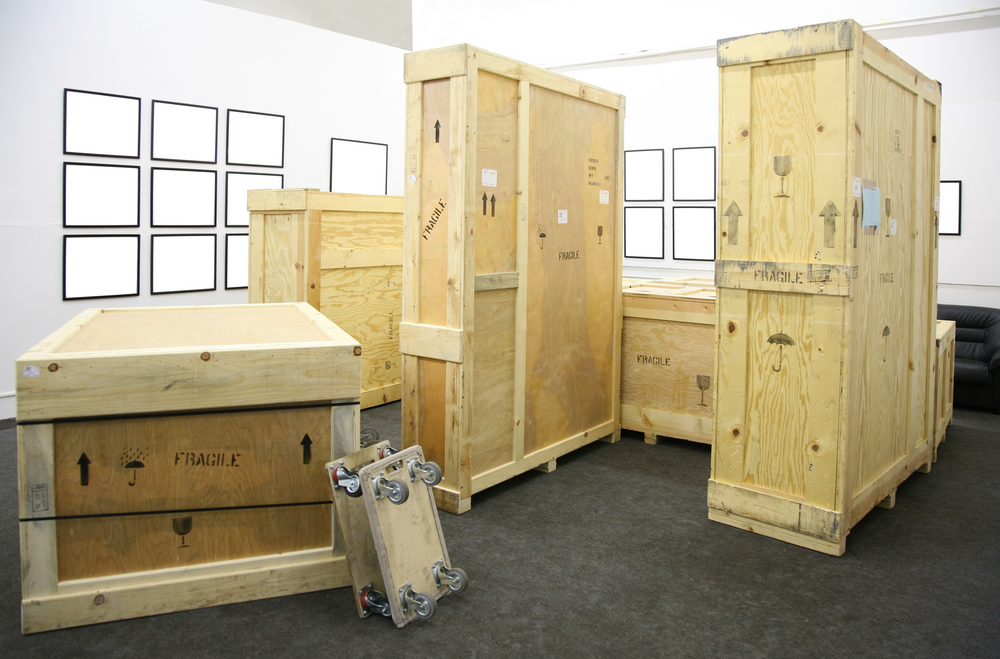In the realm of fine art, the journey from creation to public or private display is fraught with potential risks that can compromise the integrity and value of these cultural treasures. Whether it’s a priceless painting, a delicate sculpture, or a rare artifact, the importance of secure packing, reliable shipping, and optimal storage cannot be overstated. Each stage of this process plays a pivotal role in ensuring the security and protection of these irreplaceable pieces, and understanding the significance of implementing best practices in fine art shipping, packing, and storage is essential for preserving the legacy and beauty of fine art for generations to come.
How to Preserve Fine Artwork?
Protecting high-value items is an art form in itself. It involves meticulous attention to detail, and there are several key elements that will ensure the best protection of your fine art pieces:
1. Proper Art Storage Facilities
If your art isn’t on the wall, there are various specialized facilities for fine art storage that will cater to the diverse needs of art collectors and institutions. These include climate-controlled warehouses, designed to maintain consistent temperature and humidity levels, private art vaults that offer maximum security and privacy, and specialized art storage units equipped with advanced environmental monitoring systems to ensure optimal conditions for different types of artwork.
2. Regular Inspections and Careful Dusting
If your art isn’t on the wall, there are various specialized facilities for fine art storage that will cater to the diverse needs of art collectors and institutions. These include climate-controlled warehouses, designed to maintain consistent temperature and humidity levels, private art vaults that offer maximum security and privacy, and specialized art storage units equipped with advanced environmental monitoring systems to ensure optimal conditions for different types of artwork.
This real-time visibility not only satisfies the client’s curiosity but also offers practical benefits, such as the ability to plan their day around the delivery instead of anxiously waiting to spot the delivery truck by the window all day, and it allows them to receive notifications when the package is close to their doorstep.
3. Comprehensive Maintenance Schedule
Establishing a detailed maintenance schedule is important for sustaining the quality of fine art pieces over time. Plan periodic cleaning sessions, thorough inspections for signs of wear or damage, and, if necessary, timely restoration interventions. Sticking to a structured maintenance plan makes sure that fine art pieces, whether in art storage facilities or during packing art for moving, retain their value and structural integrity.
4. Collaboration with Professional Art Conservators
When addressing intricate restoration or conservation needs, seeking the expertise of qualified art conservators is imperative. These professionals possess specialized knowledge and skills essential for handling delicate materials and executing restoration processes that adhere to ethical and industry standards. Entrusting your valuable art pieces to the care of these experts guarantees their long-term preservation and safeguards their historical and artistic significance.
Of course, the specific care and handling protocols depend on the type of art. For example, UV glass is the best way to preserve artwork with powdery or loose pigments such as charcoal or pastels, as it will prevent dust, dirt, and insect contamination. When it comes to preserving artwork, a tailored approach is crucial, taking into account the unique characteristics and materials of each piece.

Important Factors to Consider
The whole process of ensuring the safest way of packing, transporting, and delivering art depends on several factors:
1. Type of Artwork
The nature and fragility of the artwork itself play a significant role in determining the most suitable protection method. For instance, delicate sculptures might require customized inserts to securely hold and protect specific parts, while paintings could benefit from foam padding to create a protective layer.
2. Transport Conditions
Considering the conditions the artwork will encounter during transit is essential. Factors such as the mode of transportation and potential environmental hazards influence the selection of protection methods. For example, artworks susceptible to temperature fluctuations might require temperature control systems, while those vulnerable to impact may need shock absorption materials.
3. Transport Duration
The length of time the artwork will be in transit also impacts the choice of protection methods. For longer journeys, ensuring robust protection against various potential risks becomes even more critical, necessitating the use of more comprehensive and durable packaging materials and techniques.
4. Storage Requirements
If the artwork will be in storage before or after transit, the specific storage conditions must be taken into account. Whether the storage facility provides climate control, adequate security measures, and protection from pests influences the need for certain protection methods, such as tamper-proof seals or specialized storage containers.
5. Artwork Value and Sensitivity
The monetary value and cultural significance of the artwork are significant considerations. Higher-value and more sensitive pieces may require an extra layer of protection, such as customized crates or advanced security measures, to mitigate the risks associated with handling and transportation.
Because of the complexity of the whole process, it is crucial to find a fine art shipping company that has a proven track record of expertise and reliability in fine art packing and shipping, as well as fine art storage services.
Ensuring Optimal Art Storage Conditions
Preserving the condition and value of fine art during storage demands meticulous attention to various challenges that can potentially compromise the integrity of these valuable pieces. Fine art storage presents a myriad of challenges, with climate control, security, and space management ranking among the most critical.
Controlling the temperature and humidity levels is crucial in preventing the deterioration of delicate materials, while effective space management ensures that artworks are stored in a manner that minimizes the risk of physical damage and environmental harm.
Moreover, cutting-edge surveillance systems, restricted access protocols, and comprehensive pest control strategies play a pivotal role in safeguarding artworks from theft, vandalism, and damage caused by pests. By fortifying these security measures, storage facilities provide a shield against potential threats, guaranteeing that your art pieces are protected and preserved in a secure and monitored environment.
Effective Fine Art Packing
Apart from optimal storage conditions, meticulous and strategic packing is imperative in protecting the delicate nature of fine art, ensuring its protection during transit and storage. When it comes to fine art packing, proper packing techniques, coupled with an expert knowledge of the materials used in each artwork, are essential to mitigate the risks of transportation-related harm, including abrasions, impacts, and environmental fluctuations.
There is much more to shipping art than placing it in standard art packing boxes; specialized packing materials play a pivotal role in fortifying the safety of valuable art pieces during transportation. Customized approaches, including the use of specific cushioning materials, secure strapping, and climate-controlled containers all provide a protective layer that minimizes the impact of external forces during fine art shipping.

Solutions for Safe Art Shipping
All fine art shippers with a good reputation have worked hard on creating a secure and reliable transportation network, ensuring that every high value item is securely and swiftly delivered to its intended destination while predicting and avoiding any potential risks of damage or delays.
When it comes to specific ways of art protection, there are many options:
1. Corrugated Containers
These are commonly used for shipping various types of artwork, providing a sturdy and protective outer layer. They come in various sizes and can be customized to fit specific artwork dimensions.
2. Custom Crates
Custom crates are tailored wooden crates designed to fit the dimensions of specific artworks, providing an extra layer of protection during transportation. They are particularly useful for fragile and valuable pieces.
3. Foam Padding
Foam padding, such as polyethylene foam or polyurethane foam, is used to create a protective layer around the artwork, minimizing the risk of damage from impact during transit.
4. Bubble Wrap
Bubble wrapping is used to provide an additional cushioning layer around delicate artwork, protecting it from scratches and minor impacts.
Because of the complexity of the whole process, it is crucial to find a fine art shipping company that has a proven track record of expertise and reliability in fine art packing and shipping, as well as fine art storage services.
5. Customized Inserts
These are tailored foam or cardboard inserts that are designed to securely hold and protect specific parts of an artwork, such as sculptures, during transit.
6. Corner Protectors
These are used to protect the corners of frames or canvases from damage during shipping, typically made of foam, cardboard, or plastic.
7. Temperature Control Systems
Temperature control systems are used for transporting temperature-sensitive artworks, ensuring that the art remains within a specific temperature range to prevent damage caused by extreme heat or cold.
8. Shock Absorption Materials
These materials, such as air cushions or packing peanuts, are used to absorb shocks and vibrations during transportation, minimizing the risk of damage to the artwork.
9. Tamper-Proof Seals
Tamper-proof seals are used to secure the packaging and provide evidence of any tampering that may have occurred during transit, ensuring the security of the artwork.
10. Secure Strapping and Taping
High-quality strapping and specialized tape are used to secure the packaging, preventing it from opening or shifting during transit.
By prioritizing the use of various specialized packaging materials, modern technology, and rigorous handling protocols, art shipping companies make sure that any transportation process, even one as complex as international fine art shipping, is carefully handled from the point of origin to its final destination.
Conclusion
The meticulous processes of packing, shipping, and storage of fine art serve as the cornerstone for preserving the rich cultural heritage and intrinsic value of these valuable creations. By employing a range of specialized packing materials, custom storage solutions, and professional fine art shipping services, Elite Anywhere makes sure that art enthusiasts and collectors can confidently rely on the expertise and adeptness of experienced professionals for the secure handling of their prized art pieces or collections.
About Us

More than just a white glove delivery company: we specialize in receiving, warehousing, shipping, and national white glove delivery & installation services.
Categories
Related posts
Ready to get started?
Experience new growth opportunities and elevate your business to the next level with our unparalleled white-glove delivery service and extensive coverage. By partnering with us, you can tap into previously undiscovered potential that will drive you closer to your goals.

Latest blog posts
From Beach to Beyond: Your Guide to Moving To and From Miami
Moving to or from Miami is an exciting adventure, filled with opportunities for new beginnings and fresh experiences.
From Packing to Unpacking: Tips for Moving to or from San Francisco
Getting ready to move to San Francisco? It’s an exciting time, but there's a lot to think about to make sure everything goes smoothly.
Elite Anywhere Moving Art Services: Your Art Deserves the Best
Elite Anywhere have a professional art moving service, ensuring your precious pieces are transported safely and securely. Read more about it!

A complete end-to-end logistics company. From receiving to last-mile delivery and everything in between, our staff delivers a true white glove experience with meticulous care and attention to detail. Need something pickup up, crated, and delivered - anywhere in the world? Let's get started!



